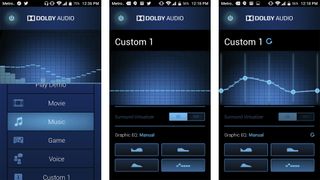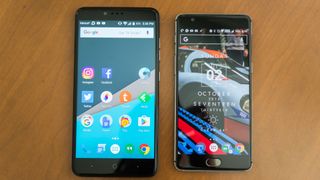Why you can trust TechRadar
Interface and reliability
- ZTE went light on the Android customizations, making the phone feel close to stock
- The included MetroPCS bloatware is annoying
ZTE took the conservative route with its software customizations, resulting in a near-stock Android 6.0 Marshmallow experience. The biggest interface tweak is the translucent notification drawer, which looks nice but can be a bit difficult to read at times. Other ZTE optimizations include a custom camera experience with manual controls, modified quick settings drawer, Wi-Fi calling and options to swap the back and multitasking buttons.

Unfortunately, the ZTE ZMax Pro is loaded with MetroPCS bloatware. MetroPCS, for whatever reason, felt the need to include its own app store. However, it requires users to allow software installation from "Unknown Sources," defeating one of Android's security layers. Thankfully, you can avoid using MetroPCS's app store altogether by using Google Play.
Music, movies and games
- Dolby's sound enhancements make the ZMax Pro sound good, but not great
- The ZMax Pro's screen is dim, making it hard to see outdoors
Listening to music with the ZTE ZMax Pro is a decent experience. Since the phone still rocks the analog headphone jack, you won't have any issues with finding compatible headphones. However, the phone's internal amplifier is a bit weak compared to other like the Galaxy S7, iPhone 7, and the OnePlus 3. This means you'll have to crank up the volume more than you would on other phones.
Music sounded just average with Dolby's software tweaks turned off. It didn't do anything wrong, but music sounded a bit flat. Turning on Dolby's optimizations, which are basically EQ presets, the ZMax Pro sounded a lot more exciting. If the included EQs aren't to your liking, you can create up to two additional presets.

The speaker on the phone is definitely where ZTE cut corners. The speaker is located at the rear of the phone where it's easily covered up by your fingers, especially when you're watching video. The speaker sounds weak and flat, and doesn't get very loud. You'll want to stick to using headphones with the ZMax Pro.
Video looks good on its 6" Full HD resolution screen. Pixel density is rated at 367 pixel-per-inch, which is good enough for a screen of this size. You won't be able to see individual pixels with the naked eye. Although, without a higher resolution screen, the ZMax Pro falls flat when it comes to VR content.

We found the ZTE ZMax Pro's screen completely serviceable, though it's dim when using outdoors. Colors are also a bit muted and contrast is a bit low compared to nicer panels from the OnePlus 3 and iPhone 7. However, for the price, it's hard to complain too much about the screen.
Games like CSR Racing and Pokemon Go played just fine, though the phone would occasionally chug, dropping frames here and there. With its midrange processor and 2GB of RAM, the ZTE ZMax Pro won't wow when it comes to gaming performance.
Specs and performance benchmark explained
- The phone feels snappy despite its mid-range specs
- There's a small amount of lag from time to time
Performance, as you'd expect from a $100 phone, isn't great but it also isn't terrible.
The ZTE ZMax Pro rocks a mid-range Qualcomm Snapdragon 617 processor and 2GB of RAM, which yields a Geekbench 4 score of 706 for single-core performance and 2194 for multi-core performance. This puts it around the ballpark of the Nexus 5 for single-core performance and similar multi-core performance as the Nexus 5x.
The ZTE ZMax Pro stutters from time to time, but we didn't mind the minor hiccups too much. For example, apps will take a split second longer to launch than they would on a flagship phone like the Samsung Galaxy S7. Scrolling through web pages also showed some stutter, but you get used to the limited performance. It's by no means a deal breaker. We were surprised at how smooth the ZMax Pro felt despite its mid-range specs.
For storage, the ZTE ZMax Pro comes with 32GB of onboard, but you can expand that storage up to 256GB with a microSD card. The phone's SIM tray doubles as a microSD card holder, like that of the Galaxy S7.
Overall, the phone feels fluid in normal use. Unlocking the phone via the rear fingerprint sensor is quick and snappy and we weren't too bothered by some occasional stuttering around the interface. Applications open up quickly and 2GB of RAM was plenty to keep some apps opened hours ago in memory.
Other features missing from the ZTE ZMax Pro are NFC, wireless charging, waterproofing, and wireless AC support. These aren't deal breakers for this $100 phone, but it's a bit disappointing not being able to use Android Pay.
Current page: What's it like to use?
Prev Page Introduction and design Next Page Battery life and cameraMost Popular



